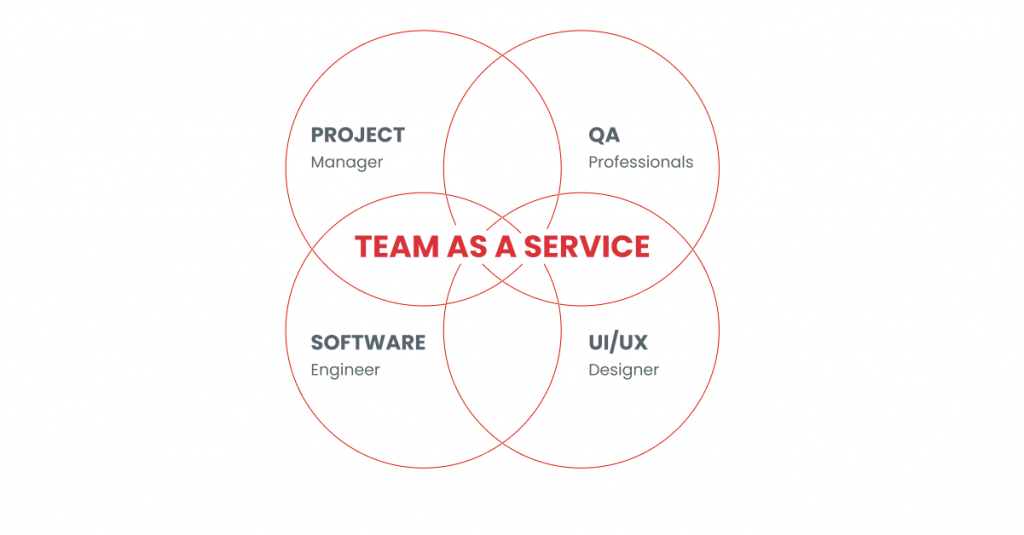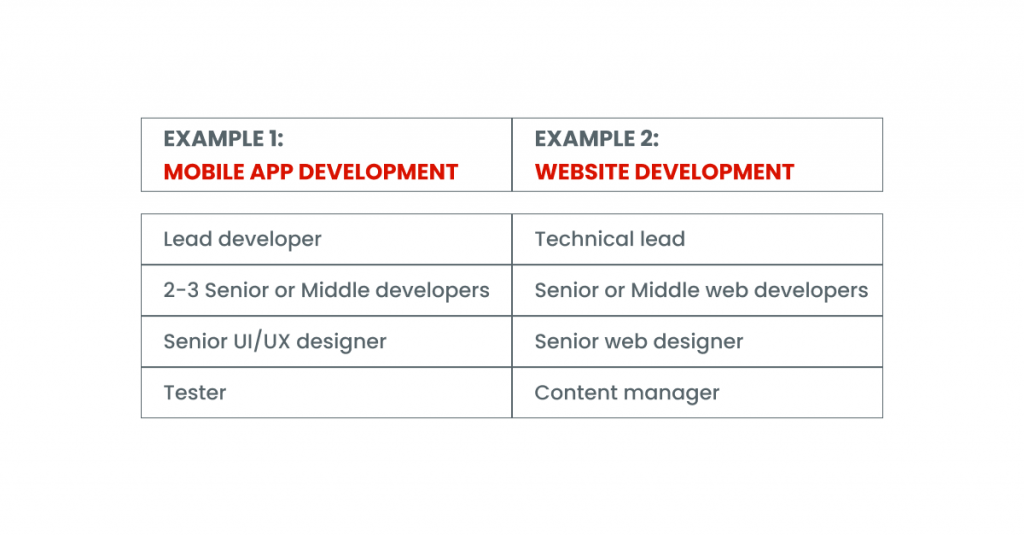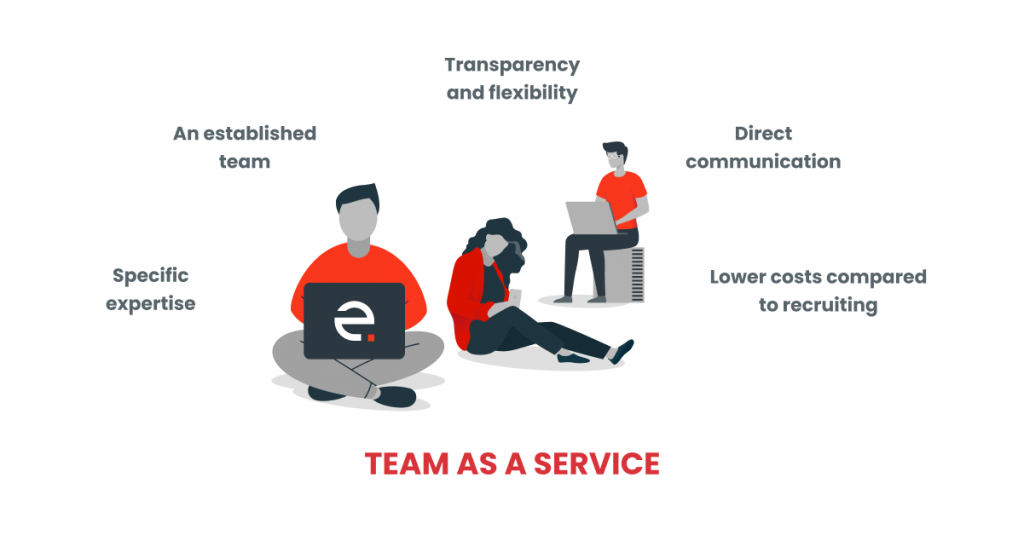Team as a Service and How Businesses Can Benefit From It

Nowadays, when the competition between IT companies is growing, it is obvious that business owners cannot waste precious resources anymore and have to be extremely strategic when it comes to product development. Team as a Service might be a fancy name for Dedicated teams or Outstaffing, but the truth is this model was born out of the real market need. Team as a Service is a modern, more efficient, cost-effective brother of Outstaffing.
In this article, we are going to define TaaS main strengths and answer the following questions:
- How does TaaS differ from other models?
- Why is the popularity of Team-as-a-service model only increasing?
- Should your business move forward with this way of involving the right candidates or with a standard recruitment and onboarding?
The differences between TaaS and Outsourcing
No doubt that there are a lot of successful modern businesses in the IT sphere. The question is how to build a strong team of professionals to create something unique? In other words, how to organize an optimized workflow and project maintenance in the best and cost-efficient way?
There are common approaches enterprises have been practicing for decades:
- In-house team creation
- Outsourcing
- Outstaffing
But implementing any of them often leads to specific issues and difficulties. Building the company’s own department seems totally easy and unproblematic at first, but first difficulties appear while trying to hire needed employees. Unlike many other industries, searching for experienced IT candidates (like programmers, test engineers, analysts, etc.) is more difficult, especially now when the Covid-19 pandemic has influenced global recruitment, it requires more effort and investments. But even more, problems arise when a project begins: terms and planned budgets increase due to many factors, the lack of needed specific expertise is one of them.
The outsourcing model
Outsourcing is when a client chooses a team outside of their company to develop an app or build a solution. This often becomes an option for those who tried to form their own in-house team but ran into difficulties.
A common problem with this model here may be the discrepancy between client expectations and the outcome in the form of the end product. The fact that lies on the surface is that outsourced workers cannot be dedicated to the client and involved in its corporate culture in the same way as their in-house employees. That’s why the quality of communication between the client and the team can suffer sometimes. Timeframes can also shift if a number of developers working on a project changes or if the client urgently needs to add one more specialist with certain expertise.
Eventually, the deciding factor in the success of a project is in coming up with clear requirements, a good description of features, communicating the product’s purpose well, and regularly reviewing the progress with the outsourcing team. If none of this is done, then the end result may drastically differ from the initial on-paper concept proposed by a client.
The outstaffing model
Outstaffing helps with huge projects. The specialists you need on your team are “rented” without being traditionally hired. The main benefit is obvious—you quickly add the required number of workers to your existing team for a specific project only. For instance, sometimes companies have their own development team, but lack expertise with a certain stack. In that case, working with a dedicated team to finish a particular product can be an excellent solution.
However, this approach has its disadvantages. It can be challenging to manage the workflow and communicating some of the product’s and company’s values. There is always support from the outstaffing side in terms of employee onboarding and engagement, but for some independent specialists who join alone, active participation can be difficult.
That’s when a Team as a Service (TaaS) comes into play. It brings to your business high-quality remote groups of dedicated pros. This model allows experts in high-demand areas to bring their experience and talent to high-impact projects.
Team as a Service model and what it means
Team as a Service allows you to work with various professionals that help your existing employees with design, development, and analytics tasks. They act as an extension of your company’s department. Projects don’t always have every possible tool to achieve an excellent outcome, so by using TaaS you maximize your potential for success and help your team with the much-needed expertise.
TaaS’s primary goal is to help businesses scale their product development. Senior talent can bring the expertise and the necessary skills to give you an edge. In the case of Ein-des-ein, we have an established group of senior- and middle-level talent that has already been cooperating together for years. This eliminates the difficulties that come with service providers that can only offer junior- and middle-level talent or gather specialists from partner networks.
That is why the possibility of facing any trial-and-error issues with candidates is quite low. Collaboration environment and team-building problems have already been mitigated without your participation through years of work.

Such a motivated, expandable, experienced squad operates properly, accumulates subject expertise, solves problems timely without increasing costs.
The idea of TaaS is pretty similar to well-known Software as a Service: when new professionals are needed, they are “plugged in” to meet your urgent needs. Such an approach also requires minimal training so the development process can start right away and remotely. When the project is complete, it can be “unplugged” just as a software extension. Choosing TaaS’s based on their specialization allows a client company to effectively work on multiple projects at the same time, simply collaborating with different Teams as a Service.
What does TaaS include and bring to companies?
Speaking about IT projects, various TaaS may be effective at different stages starting from the ideation and business analysis, followed by design and development, and the product post-launch optimization and promotion. That’s why there also exist:
- Product Team as a Service
- Marketing as a Service
- Software Development as a Service
For example, speaking about the last one, it may include permanent programmers, test engineers, UI/UX Designers. The rest of the participants would be technical writers, system analysts, DevOps, project managers. Plus, you don’t have to stick to a particular technology as you choose among supported ones in your company. There are plenty of options including various open-source stacks like PHP, Javascript HTML, and CSS, etc.
Apart from software development, website development, mobile app development services, and design, TaaS can focus on IT-related functions as well. You can hire professional HR managers, sales pros, or crisis/growth specialists to improve your revenue pipeline as well.

Advantages of Team as a Service
Many businesses select TaaS to add the expertise they don’t have in-house. Another reason is chasing a “burning” deadline or trying to accomplish an important milestone that demands a lot of resources. And we shouldn’t forget about the long-term cost-saving aspect. Reasons vary but the conclusion is clear: Team as a Service model provides countless benefits and ROI growth for the companies that opt for it.
Direct communication
The customer simply interacts with the team as if it were his own in-house department. Unlike outsourcing, customers have the chance to communicate directly with each team member. There is usually a Project manager appointed by the client who is responsible for everyday organizational issues, but it is also possible to hire a Project manager as part of the Team as a Service.
Once again, compared to outsourcing, it is more convenient to avoid issues related to administrative paperwork, recruitment, contract design, and extra staff supervision. In other words, businesses are always in control over what’s essential for the project and overall success.
Collaborative management
Traditionally, all the processes are coordinated by the IT Provider with Human Resources leading the way. With TaaS model there is always a team behind the Team. It means that there is always someone responsible for the proper work ethic, consultations, possible problem-solving. Team leaders and HR managers from the provider side make sure TaaS works efficiently towards expected results. This helps save time and resources on the client side.
Many technologies supported
At ein-des-ein, we have development teams for the Node.JS stack, the Vue stack, as well as more traditional Java/Scala. We have experienced native iOS and Android mobile teams. When it comes to the variety of expertise, we got senior experts in AWS, Azure, Micro Services, and UX/UI design. For a full list of technologies, reach out to us directly.
Expertise that saves time and money
When an organization is experiencing increasing workloads, placing more and more difficult tasks on your existing employees’ shoulders often leads to burnouts and low productivity. The solution is to find professionals whose expertise 100% meets your expectations so they can not only pick up urgent tasks quickly but also solve recurring issues.
From the recruitment point of view, TaaS development may be considered a major time-saver. You go past such recruitment phases as initial candidate screening, a series of interviews, offer preparation, and probation period possible issues. The overall process takes a lot of time and it’s best to avoid wasting it.
Team flexibility and involvement
TaaS is fully flexible and fully adapts to project needs. No matter if you decide to delegate a specific task, for example, an upcoming product roadmap, or would like to set up quick calls to keep up with the latest improvements, it is up to you. The team will follow the new guidelines along with daily meet-ups.
Don’t be afraid to communicate with involved specialists on every level. Stakeholders define the plan from the start. Both providers and a client discuss a product roadmap, sprint goals, etc. so when all aspects are clear, TaaS is able to get on it.
With the TaaS approach, you get to work with a highly professional squad that is ready to rock! With the agile way of working, our development teams are used to working efficiently. Clients and the team can do the daily standups and planning sessions via remote online communication. Our teams use Atlassian Jira, Skype, Slack, and Telegram but can quickly adapt to any other tools and instruments that you prefer.
Quick project-to-project HR changes
Using TaaS you easily bring on new skilled staff for your upcoming projects. The overall hiring process becomes flexible, more transparent, and optimized. You are able to make changes any second or simply integrate teams together. Without typical hiring issues, you are able to focus on results. Moreover, all possible admin costs are not a client’s responsibility so you continue working with the chosen group of professionals without worrying about these aspects.
During the hiring process, you deal entirely with the TaaS provider, optimizing and streamlining the processes. After the hiring process is complete, it is crucial to establish a connection between in-house employees and TaaS members. There is usually no competition as TaaS is there to empower the existing team and help reach a new level. In addition, it is necessary to share the organization’s values with the new team and treat TaaS workers as important reinforcement and support.

Conclusion
No matter what part of your existing team is “missing” at the moment, there are various options for finding the right fit. You may choose a suitable variant among good old outsourcing or outstaffing models. Or you can religiously look for candidates on the market. While each model has its benefits, the Team as a Service approach is perfect for projects with long-term ambitious goals.
TaaS has all the chances to become the best solution for your business due to many reasons. You can achieve more with an already formed group of professionals that you can “switch on” any time you need. Compared to a long recruitment path, there are no lengthy hiring and onboarding processes. Moreover, an adaptation phase is minimal, just give them a technical task and requirements and they are good to go.
This approach allows you to eliminate possible problems at an early stage with minimal costs. Experienced managers are responsible for the results so you are able to focus on certain work aspects with no additional costs. There is no competition between TaaS members as they have already been working together for years. And they definitely know how to optimize their workflow. So you get to work with dedicated developers ready to rock!
No need to do more after the milestone is reached? Just “switch off” your current Team as a Service and continue improving your product with your in-house team.

Looking for a development partner? If you’re looking for an outsourcing partner, development team augmentation, or just someone to help you with your web and app development initiatives, consider Ein-des-ein.